
94% of researchers rate our articles as excellent or good
Learn more about the work of our research integrity team to safeguard the quality of each article we publish.
Find out more
ORIGINAL RESEARCH article
Front. Sustain. Food Syst., 17 May 2023
Sec. Nutrition and Sustainable Diets
Volume 7 - 2023 | https://doi.org/10.3389/fsufs.2023.1187717
This article is part of the Research TopicDiversified Agri-food Production Systems for Nutritional SecurityView all 17 articles
 Kirttiranjan Baral1
Kirttiranjan Baral1 Yashbir Singh Shivay1*
Yashbir Singh Shivay1* Radha Prasanna2
Radha Prasanna2 Dinesh Kumar1
Dinesh Kumar1 Manoj Shrivastava3
Manoj Shrivastava3 Debashis Chakraborty4
Debashis Chakraborty4 Rajesh Kumar5
Rajesh Kumar5 Cherukumalli Srinivasarao6
Cherukumalli Srinivasarao6 Sunil Mandi7
Sunil Mandi7 Somanath Nayak1
Somanath Nayak1 Kadapa Sreenivasa Reddy1
Kadapa Sreenivasa Reddy1 B. S. Yashavanth6
B. S. Yashavanth6Identifying appropriate nutrient management options is crucial for reversing the yield plateau and enhancing the nutritional status of basmati rice under the basmati rice-wheat cropping system of the Indo Gangetic Plain (IGP). Alternative to the conventional chemical fertilizer, ZnO nanoparticles as carrier material for the micronutrient Zn has shown promise in reducing the bulkiness of fertilizer use in the soil–plant environment. But whether its integration and interaction with an organic source such as green manuring could enrich basmati rice grain with micronutrients and promote protein nutrition is not well investigated. Therefore, we conducted a field experiment during the summer and rainy seasons (April–October) of 2020 and 2021 at the research farm of the ICAR-Indian Agricultural Research Institute, New Delhi in a split-plot design with two summer green manuring (SGM) options (Sesbania and cowpea, along with fallow) as main plots and six fertilization strategies as subplots: 5 kg Zn ha−1 as bulk ZnO, N at 120 kg N ha−1 as prilled urea (PU), N at 120 kg N ha−1 as PU + 5 kg Zn ha−1 as bulk ZnO, 1% bulk ZnO-coated PU, 0.1% nano ZnO coated PU and 0.2% nano ZnO coated PU replicated thrice. On average, SGM increased basmati rice grain yield by 13.2 and 12.3% during 2020 and 2021, respectively compared to fallow. Integrated application of zinc with urea significantly (p < 0.05) increased the grain yield of basmati rice by 9.56% and by 10.5% relative to urea without zinc and by 33.7 and 33.8% than the sole application of 5 kg Zn ha−1 through ZnO, respectively during 2020 and 2021. On average, SGM boosted Zn, Cu, Mn, and Fe content in milled rice by 25, 22.38, 20.0, and 18.85% during 2020 and 23.75, 21.4, 19.6, and 13.3% during 2021, respectively compared to fallow. Relative to sole urea application, zinc, and urea together improved the Zn and Fe content in milled rice by 2.99 mg kg−1 and 2.62 mg kg–1, respectively during the first year and by 2.83 mg kg−1 and 2.6 mg kg−1, respectively during the second year of study. The highest protein content in basmati rice grain was observed when it was grown after Sesbania aculeata residue incorporated plot during both the years and it decreased in the order: Sesbania aculeata > Vigna unguiculata > summer fallow. Our findings revealed that with the application of 1% bulk ZnO coated PU with Sesbania; the yield response, micronutrient acquisition, and protein accumulation in milled rice was higher than in other plant fertilization methods. However, in plots treated with Sesbania, along with 0.2% nano ZnO-coated PU exhibited statistically equivalent yield and micronutrient loading in edible tissues. Hence, this study unveils the critical role of nano ZnO-coated urea and summer green manuring in elevating micronutrient and protein bioavailability in basmati rice and concurrently reducing Zn dose by 20%, making it a profitable option for farmers.
In Asia, about 24 million hectares (Mha) of land is devoted to the rice (Oryza sativa L.)-wheat (Triticum aestivum L.) cropping system (RWCS) (Nawaz et al., 2019). This system is most prevalent in South Asia’s Indo-Gangetic Plains (IGP), where India alone holds 10.3 Mha land under this particular cropping system (Timsina and Connor, 2001). Rice and wheat together contribute about 45% of digestible calories, 30% of protein, and a considerable percentage of animal feed worldwide (Evans, 1996). In India, RWCS contributes 31% of food grain output (Prasad, 2005) demonstrating its significance in ensuring national food security. India produces 20% of the world’s rice, making it the second-largest rice producer. To meet the needs of its expanding population, India plans to increase rice production to the tune of 130 million tonnes by 2030 (Kumar et al., 2021). India relies extensively on RWCS to provide not just food security, but also nutritional security. However, the sustainability of the rice under RWCS has emerged as a major emerging challenge during the last decade. Some of the predominant reasons include stagnating yields, decreasing crop responses to external mineral fertilizer, multi-nutrient deficiencies, dwindling factor productivity (land, water, labor, etc.), and the use of repeated wet tillage, which oxidizes buried organic matter and breaks down macro-aggregates negatively impacting soil health (Bhatt et al., 2016). Furthermore, keeping the land idle during the intervening period of two crops does not provide any financial benefits to producers. All these factors contribute to the poor financial situations of farmers leading to agriculture becoming a non-profitable livelihood. The Global Hunger Index (2022) depicts that India ranks 107th out of 121 nations, with a score of 29.1 which is an indicator of a serious hunger problem in the country. Anthropogenic climate change will further negatively impact the grain quality of rice (Lin et al., 2010). Since soil, plant, and human health are interconnected, India’s agri-food system, especially rice in the RWCS, must be transformed to provide food and nutritional security, increasing profits without compromising soil quality.
Increasing the profitability of rice under RWCS may need adopting a vertical crop diversification approach, such as switching from ordinary rice genotypes to high-yielding basmati genotypes that have a high value in international trade. Due to its unique characteristics (such as a pleasant aroma and an extended grain length after cooking), basmati rice has a lot of potential for export. In the fiscal year 2021–22, India earned US $3,540.40 million from the export of basmati rice, making it the world’s largest exporter (APEDA, n.d.). Improving the nutritional quality of the basmati rice to combat mineral shortages and malnutrition would be a win-win situation for everyone involved in RWCS, in addition to bringing in much-needed foreign currency.
The manifestation of any trait in a plant depends on genotype, environment and the dynamic interplay between genotype and environment. Since soil is one of the most significant environmental factors affecting yield and nutritional content in grains, it must be carefully attended to break open the abeyant high yield potential and nutrient-dense grains of basmati rice genotypes. In this perspective, sustainable intensification of the fallow period in RWCS by integrating summer green manuring crops (SGM) might be one of the feasible solutions for sustainable land use and most crucially recovering soil health affected by soil harmful intense tillage operations performed under the present system. Numerous studies have demonstrated the efficacy of green manure in boosting agricultural productivity, mitigating soil erosion, lowering runoff and nitrate leaching during the fallow period, decreasing soil bulk density, raising the levels of organic matter, N, P, K, and other nutrients in the soil to lessen the need for synthetic fertilizers, maintenance of soil biodiversity and enzyme activity, etc. (Mandal et al., 2003; Salahin et al., 2013; Ma et al., 2021). Additionally, it is well established that leguminous green manures have high fertilizer value on the succeeding crops due to their ability to fix atmospheric nitrogen. Green manuring coupled with chemical fertilizer can help ensure the long-term viability of RWCS (Yadav et al., 2000). An earlier study reported that Sesbania green manure could partially replace chemical fertilizer, increase rice yield, and reverse the declining trend of partial factor productivity (PFP) in wheat. Leguminous green manures mineralize more quickly and release both macro- and micronutrients factored by their lower C/N ratio. Additionally, the incorporation of green manure can improve the bioavailability of micronutrients by chelation through the production of organic acids (Singh and Shivay, 2019).
Among the essential micronutrients, zinc (Zn) is one of the most crucial micronutrients for crop production because it is a key structural component or regulatory co-factor of numerous enzymes and proteins in many crucial biochemical pathways, including protein metabolism, auxin synthesis, pollen formation, the preservation of the integrity of biological membranes, and carbohydrate metabolism (Alloway, 2008). However, its deficiency is more evident in high pH calcareous soils in the North Western Indo-Gangetic Plains (IGP), which is linked to greater Zn sorption on the soil as hydroxides and carbonates (Prasad, 2006). Further, the prolonged submerged condition of the rice is one of the causes of the Zn deficiency in rice in particular. In this context, green manuring with Sesbania (Sesbania aculeata Pers.) has shown promising results for improving soil zinc bioavailability and producing Fe, Mn, Cu, and Zn-dense grains in basmati rice (Pooniya and Shivay, 2013). Limited scientific research has also indicated the benefits of SGM in rice under RWCS (Thind et al., 2019; Sharma et al., 2021), but it is important to consider how its integration and adoption in the present system can increase productivity, nutritional security, and profitability. Organic manures, such as green manuring, can improve soil fertility and health, but their slower mineralization rate is out of sync with plant needs, as they cannot be relied on alone to provide the plants’ nutritional demands during the crop season. Thus, the present focus on enhancing agricultural productivity and crop quality is preferred to the use of chemical fertilizers, however it is linked to a number of unfavorable environmental outcomes, such as soil hardening, decreased fertility, reduced activity of native soil microorganisms (and thus a decrease in soil biodiversity), alteration in soil pH, and the formation of a crust on the soil’s surface (Pahalvi et al., 2021). Rice being nutrient intensive, there is a pressing need to pay crucial attention to make optimal use of fertilizers, which are becoming more expensive with time.
As a result, the co-application of organic and inorganic nutrient sources needs to be appropriately maneuvered in order to capitalize on the synergism that exists between them. Green manure increases nitrogenous fertilizer efficiency for two main reasons: (a) green manure N is as efficient as urea N in rice (Ladha and Kundu, 1997), and (b) higher root density of subsequent wheat due to improved soil physical conditions enhances nutrient acquisition capacity and biological yield at a given fertilizer level (Boparai et al., 1992). In this context, the use of slow-release fertilizer has been an effective method of nutrient administration because it releases nutrients gradually, at the rate preferred by the plant, and it keeps those nutrients in the soil for an extended length of time. A study by Cole et al. (2016) suggested the benefits of slow-release fertilizer and reported it as an efficient way of administering nutrients as they are made available to the target at the desired rate or concentration level, hence sustaining the nutrients in the soil for a longer period. Enhanced nutrient use efficiency, especially for nitrogen (N) has been achieved through the use of conventional coated urea category of fertilizers such as neem-coated urea in tropical lowland rice (Mohanty et al., 2021), sulfur-coated urea in spring wheat (Shivay et al., 2016), and zinc-coated urea in RWCS (Shivay et al., 2008), etc.
The use of innovative nano-fertilizers like nano zinc oxide (ZnO) has recently reshaped the definition of enhanced fertilizer use efficiency in the agriculture sector. In comparison to traditional fertilizers, it is fundamentally different due to its unique physical, chemical, and biological properties. These fertilizers have a nutrient release rate that corresponds with crop needs, which helps in maximizing nutrient recovery and reducing nutrient losses. Also, because plants only need small amounts of these fertilizers, the greenhouse gas emissions during their production and transportation are very low. According to Pavithra et al. (2017), ZnO nanoparticles increased rice grain Zn content and grain production. The use of zinc nano fertilizer (ZnNFs) resulted in increased plant growth in pearl millet (Tarafdar et al., 2014). Applying ZnNFs (<100 nm) in maize crop has reportedly increased the plant height, root length, root volume, and dry weight of the root (Adhikari et al., 2015). In wheat, seed priming with 75 and 100 mg/l of ZnNFs has reported enhanced shoot Zn concentration (12–24%) and root Zn concentration (13–19%), compared to the control (Rizwan et al., 2019). Further, zinc oxide-coated urea has a favorable influence on grain yield and Zn content in a rice-wheat system (Shivay et al., 2008). Another study by Dimkpa et al. (2020) suggested that coating urea with nano-ZnO improved plant performance and Zn accumulation in wheat. However, the majority of the investigations have concentrated on the effect of the sole application of ZnO nanoparticles on plants. There is a dearth of research on the combining effect of summer green manuring (SGM) with the use of nano-ZnO-coated urea (NZCU). In addition, the relative efficacies of NZCU vis-à-vis bulk ZnO-coated urea with respect to grain quality of rice under RWCS have not been tested.
Therefore, the present study was contemplated with two primary objectives: (1) To elucidate the comparative efficacies of different green manure crops and diverse zinc sources on the yield response of basmati rice under RWCS, and (2) To decipher the nutritional composition particularly micronutrient and crude protein content of basmati rice as influenced by the integrated use of summer green manuring and zinc sources.
The field experiment was conducted for two consecutive years at the research farm of the ICAR-Indian Agricultural Research Institute (IARI), New Delhi, India during the summer-rainy seasons of 2020 and 2021. The Institute farm lies at latitude 28°38′ 24′′ N, longitude 77°10′ 26′′ E and 228.6 m above sea level. During the basmati rice crop period of 2020 and 2021, mean rainfall was 802.5 mm and 1534.3 mm, mean evaporation was 772.4 mm and 688.3 mm, maximum daily temperature range was 28.4–43.3°C and 24.2.6–43.8°C, and minimum daily temperature range 10.9–31.7°C and 12.6–32.5°C, respectively. Daily variation in the agrometeorological parameter is presented in Supplementary Figure 1 (SF1).
Table 1 depicts the soil’s physical and chemical parameters.
The experiment was conducted in a split-plot design with one summer fallow (G1) and two green manure crops [Sesbania aculeata (G2), Vigna unguiculata (G3)] as the main plot and six subplots comprising 5 kg Zn ha−1 as bulk ZnO (80% Zn) [(control for N), Z1], nitrogen (N) at 120 kg N ha−1 as prilled urea [(control for Zn), Z2], N at 120 kg N ha−1 as prilled urea +5 kg Zn ha−1 as bulk ZnO (80% Zn) (Z3), 1% bulk ZnO coated prilled urea [N at 120 kg N ha−1 + 2.08 kg Zn ha−1 as bulk ZnO, Z4], 0.1% nano ZnO coated prilled urea [N at 120 kg N ha−1 + 0.208 kg Zn ha−1 as nano ZnO, Z5] and 0.2% nano ZnO coated prilled urea [N at 120 kg N ha−1 + 0.416 kg Zn ha−1 as nano ZnO, Z6] replicated three times. The Sesbania (variety: Punjab Dhaincha 1) and cowpea (variety: Pusa Komal) seeds were sown at 50 kg ha−1 and 35 kg ha−1, respectively, and at 22.5 cm apart, using a seed drill during the third week of May during both years of study and incorporated into the soil at 45 days after sowing (1 week before transplanting of basmati rice).
The ZnO used in our experiment was purchased from Sigma Aldrich Chemical Co., United States and characterized using the following techniques.
X-ray diffraction (XRD) data of materials used (both bulk and nano) was collected using an X-ray diffractometer (Philips PW 1710), equipped with copper Kα radiation as the X-ray source (2θ range of 4–48°) operated at 40 kV and 20 Ma tube current. It was observed that all the peaks were matching with the standard data of the hexagonal ZnO wurtzite structure (JCPDS card no. 36–1,451; Figure 1).
Both bulk and nano zinc oxide were characterized for their particle size by Zetatrac™ particle size analyzer based on the Dynamic Light Scattering (DLS). The 95% of the nano ZnO particle size had a diameter of <74 nm (confirming the nano size of nano ZnO, i.e., <100 nm) and it was < 3,430 nm (beyond 100 nm) in bulk ZnO (Figures 2A,B; Table 2).
SEM was used to examine the surface morphology and cross-section. The presence of bulk and nano ZnO on the urea granules was clearly depicted in SEM micrographs, demonstrating efficient surface coating, whereas the absence of ZnO provided evidence of a lack of zinc coating (Figures 3A–F). Furthermore, a Field Emission Scanning Electron Microscope (FESEM) FEI Quanta 200 FESM (FEI, Netherlands) equipped with an Oxford EDX system IE 250 X Max 80 was used to conduct elemental analysis and to determine the presence or absence of Zn. As expected, peaks for carbon, oxygen, and nitrogen were observed in the sole urea granules. The Zn peak was seen in all of the coated urea granules, in addition to the peaks seen in the uncoated granules (Figures 4A–F). The granules that were not coated had no zinc.
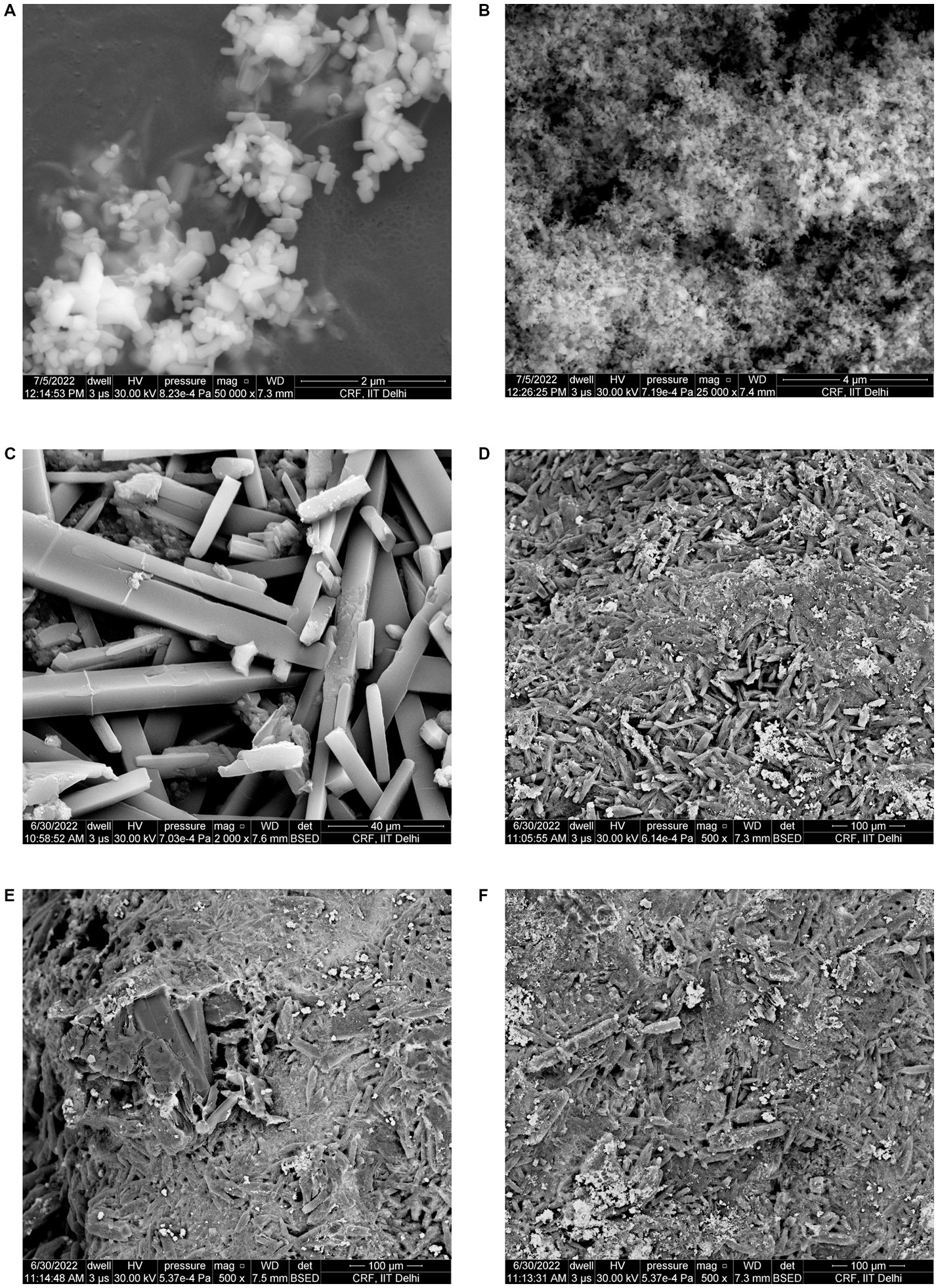
Figure 3. (A) SEM of bulk ZnO. (B) SEM of nano ZnO. (C) SEM of urea granule. (D) SEM of 1% bulk zinc-coated urea. (E) SEM of 0.1% nano zinc-coated urea. (F) SEM of 0.2% nano zinc coated urea.
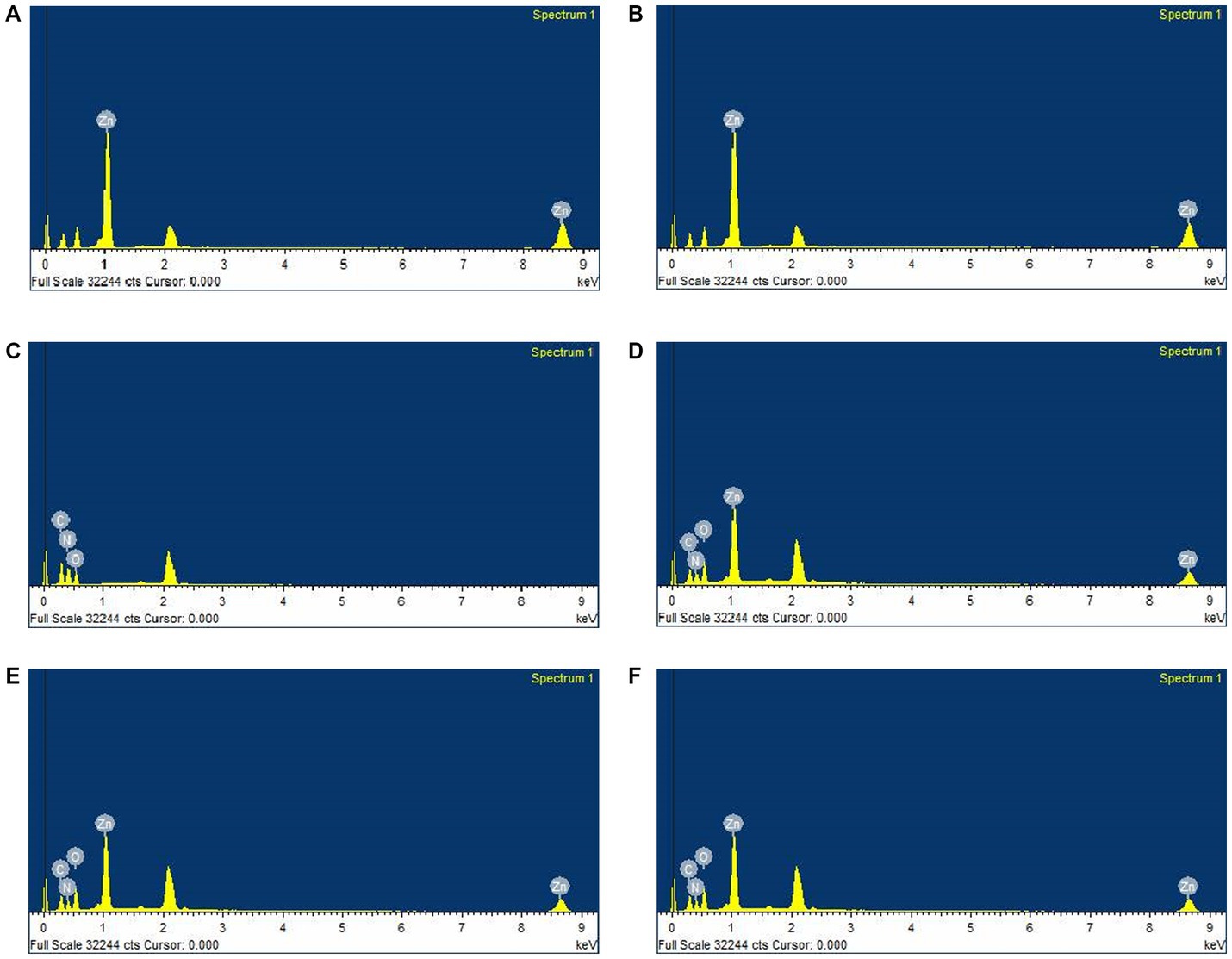
Figure 4. (A) EDX of bulk ZnO. (B) EDX of nano ZnO. (C) EDX of urea granule. (D) EDX of 1% bulk zinc-coated urea. (E) EDX of 0.1% nano zinc-coated urea. (F) EDX of 0.2% nano zinc-coated urea.
The sample for transmission electron microscopy (TEM) was prepared from dispersions of nano zinc oxide sonicated for 40 min at room temperature and followed by placing it on a carbon-coated grid using a micropipette and staining the grid with 2% uranyl acetate. The materials placed were observed for morphology and size using a TEM (Jeol 1,011, Japan) operating at 100 Kv. The ZnO nanoparticles were well in the nano range (1–100 nm; Figure 5). Some larger aggregates in the sample are linked to the high surface energy of nano-particles.
The total dry matter, N, and micronutrients added by green manuring are presented in the Supplementary Tables S1, S2, respectively.
Two or three seedlings (25 days old) of rice variety ‘Pusa Basmati 1401’ (seed rate 20 kg ha−1 used to raise the nursery) were transplanted at a spacing of 20 cm by 10 cm in the first fortnight of July 2020 and 2021, respectively. Recommended doses of N, P, and K (120.0, 26.2, and 33.3 kg ha−1) were applied in the form of urea, single super phosphate, and muriate of potash. P, K, and 5 kg Zn ha−1 as soil application was applied as basal during the transplanting of basmati rice. Nitrogen (in the form of prilled urea and zinc-coated urea) was applied in three equal splits: one-third as basal, one-third at 50% tillering, and one-third at the panicle initiation stage. The rice crop was grown as per the recommended agronomic practices and was harvested in the last week of October during both study years.
Harvested plant samples were sun-dried, oven-dried at 60 ± 2°C in a hot-air oven for 6 h, and crushed. Chemical analysis was performed on 0.5 g of plant samples from different parts of rice grain and straw. Micronutrient content in dry matter was evaluated by the di-acid digestion method using atomic absorption spectrophotometry (Prasad et al., 2006), and uptake was calculated by multiplying corresponding values by dry matter and expressed in g ha−1. Plant samples of 0.5 g were digested in 10 ml of analytical-grade concentrated H2SO4 with a digestion mixture and analyzed in a Kjeldahl device to determine N% (Prasad et al., 2006). Husk, white rice kernel, and bran protein were calculated by multiplying N concentration by 5.95 (Juliano, 1985).
Statistical computation was performed using R software (version 4.2.2) and R-Studio (version 2022.12.0 + 353) by using “agricolae” (De Mendiburu and de Mendiburu, 2019) and “psych” packages (Revelle and Revelle, 2015). Duncan’s multiple range test (DMRT) was performed for grouping of treatment means. p values were computed for estimating the significance of the treatment mean.
Both summer green manuring (SGM) and zinc fertilization (ZF) significantly influenced the grain yield of basmati rice during both years of study (Figures 6, 7). Results of contrast analysis (Table 3) indicated that; averaged over ZF treatments, SGM significantly produced a higher yield (p < 0.001) than fallow (G1). On average, SGM increased basmati rice grain yield by 13.2 and 12.3% during 2020 and 2021, respectively compared to fallow (G1) (Figure 6). Of the SGM, Sesbania green manuring (G2) recorded numerically higher grain yields during both years of study which was also significantly different from cowpea green manuring (G3) (Figure 6). Averaged over ZF treatment, Sesbania green manuring (G2) increased basmati rice grain yield by 18 and 17% compared to fallow (Figure 6) during 2020 and 2021, respectively. Likewise, cowpea green manuring (G3) increased basmati rice grain yield by 8.42% and by 7.85% compared to fallow (Figure 6) during 2020 and 2021, respectively. Further, conjoint use of zinc with urea (both coating and separate application) significantly improved the grain yield (p < 0.05) of basmati rice than sole urea application (Z2) and soil application of 5 kg Zn ha−1 through ZnO (Z1) as evident by contrast analysis (C2 and C3; Table 3) during both years of study. Integrated application of zinc with urea significantly (p < 0.05) increased the grain yield of basmati rice by 9.56% and by 10.5% relative to urea without zinc and by 33.7 and 33.8% than the sole application of 5 kg Zn ha−1 through ZnO (Z1), respectively during 2020 and 2021 (Figure 7). Among ZF, application 1% BZCU (Z4) gave the highest yields, although not significantly different from the application of 0.2% NZCU (Figure 7), however, both outperformed other ZF treatments. There was a significant SGM × ZF effect for grain yield response (Table 4). A combination of Sesbania green manuring (G2) and the application of 0.2% NZCU demonstrated a higher grain yield response (Table 5 and Figure 8).

Table 3. Orthogonal contrasts (depicting value of p) for grain yield and micronutrient content in milled grain of basmati rice as influenced by summer green manuring (SGM) and zinc fertilization (ZF).
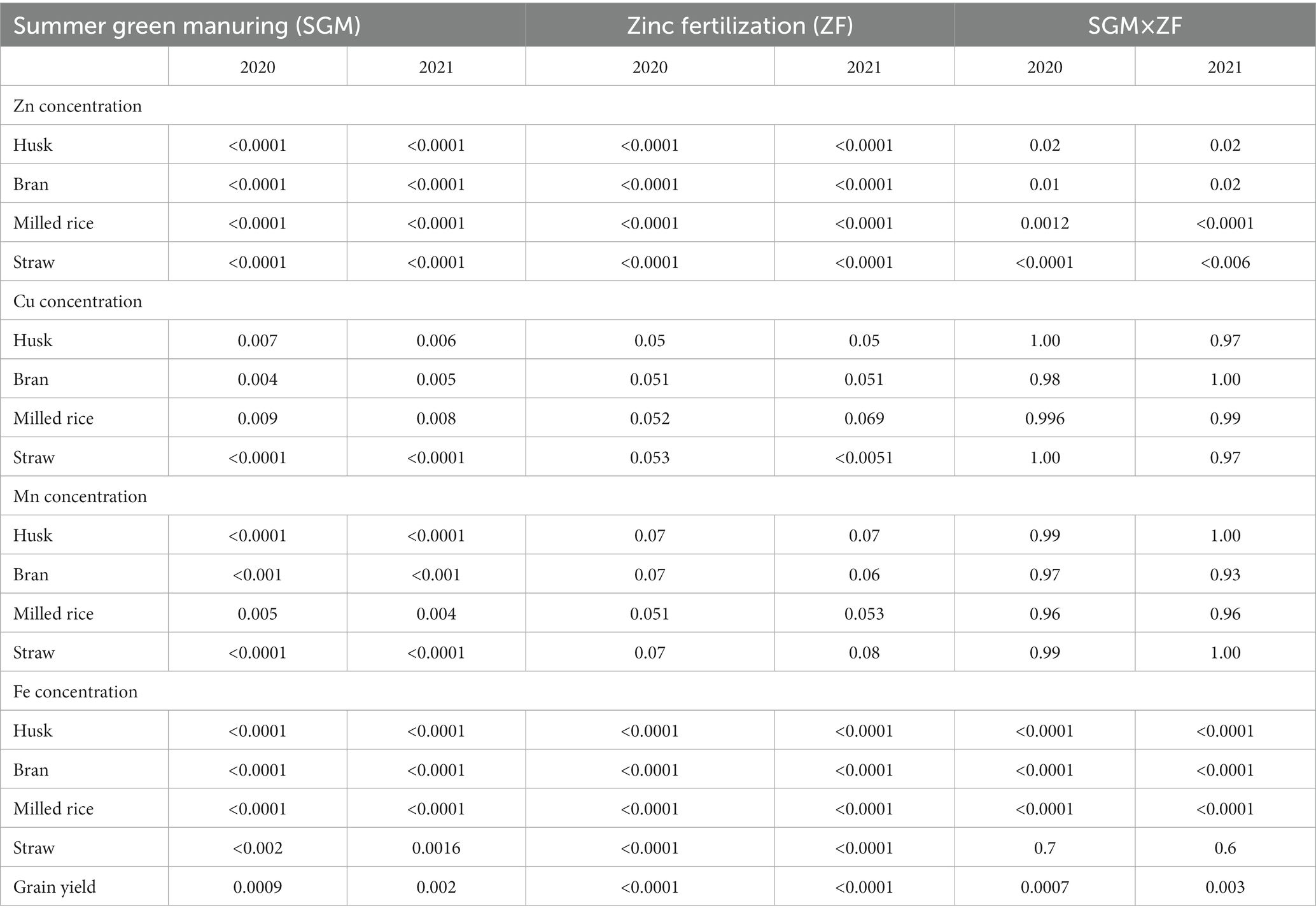
Table 4. Analysis of variance (ANOVA) results (value of p) for the effect of summer green manuring and zinc fertilization on Zn, Cu, Mn, and Fe concentration in the different parts of grain, straw, and grain yield of basmati rice.

Table 5. Grain yield response of basmati rice to combine the application of summer green manuring (SGM) and zinc fertilization (SGM × ZF).
The Zn, Cu, Mn, and Fe concentrations in different parts of grain and straw in response to SGM and ZF are presented in Tables 6–10. Across all SGM and ZF levels, straw had higher micronutrient concentrations than grain (Tables 6–10), with the order being Fe > Zn > Mn > Cu. In both years, micronutrient concentration decreased in the order of bran > hull > milled rice. On average, the content of Zn, Cu, Mn, and Fe milled rice was 13.57, 4.61, 42.56, and 144.9 mg kg−1 during 2020 and 13.9, 4.81, 42.8, and 145.8 mg kg−1 during 2021. Likewise, in the straw, the average concentrations of Zn, Cu, Mn, and Fe were 70.16, 8.03, 5.67, and 9.54 mg kg−1 and 69.91, 8.13, 5.77 and 9.77 during 2020 and 2021, respectively, irrespective of SGM and ZF. Both SGM and ZF significantly influenced the micronutrient content during both years of study (Table 4). Contrast analysis (Table 3) revealed that; averaged over ZF treatments, SGM significantly produced micronutrient-dense milled rice (p < 0.001) than fallow (G1). Of the SGM, Sesbania green manuring (G2) recorded numerically higher Zn, Cu, and Fe content in milled rice than fallow (G1) during both years of study, however, Cu and Fe concentration in milled rice was statistically equivalent with G3. In contrast, cowpea green manuring (G3) significantly outperformed the other two (G1 and G2) with respect to Mn content both in milled grain and straw (Table 9). On average, SGM boosted Zn, Cu, Mn, and Fe content in milled rice by 25, 22.38, 20.0, and 18.85% during 2020 and 23.75, 21.4, 19.6, and 13.3% 2021, respectively compared to fallow (G1). Averaged over ZF treatment, Sesbania green manuring(G2) increased Zn, Cu, Mn, and Fe content in milled rice by 30, 30.3, 11.8, 20, and 22.5%, 28.57, 11.7, 15.5% compared to fallow during 2020 and 2021, respectively. Likewise, cowpea green manuring (G3) enhanced Zn, Cu, Mn, and Fe content in milled rice 21.42, 14.4, 28.2, 17.64 and 20%, 14.28, 27.4, 11.11% compared to fallow during 2020 and 2021, respectively.
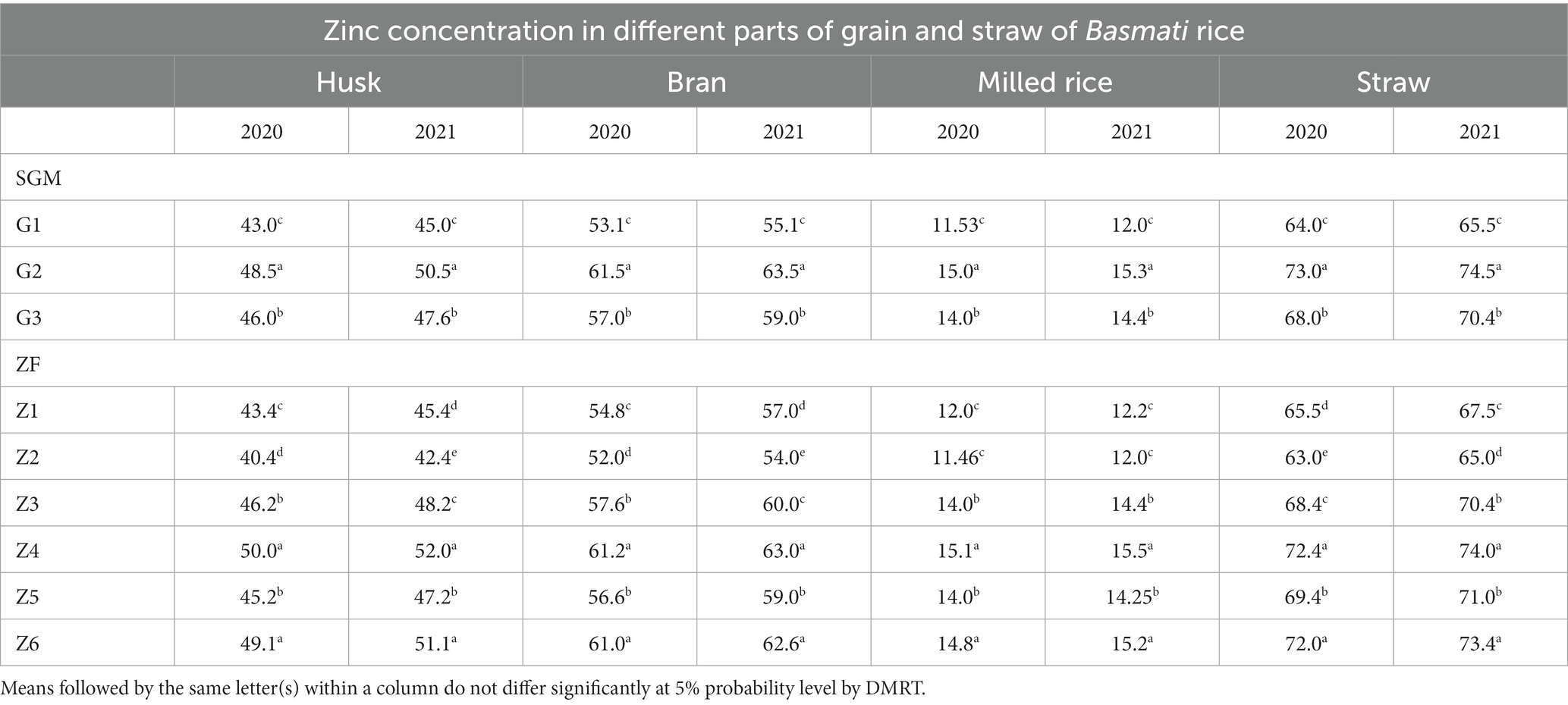
Table 6. Summer green manuring (SGM) and zinc fertilization (ZF) on Zn concentration (mg kg−1) in different parts of grain and straw of basmati rice.
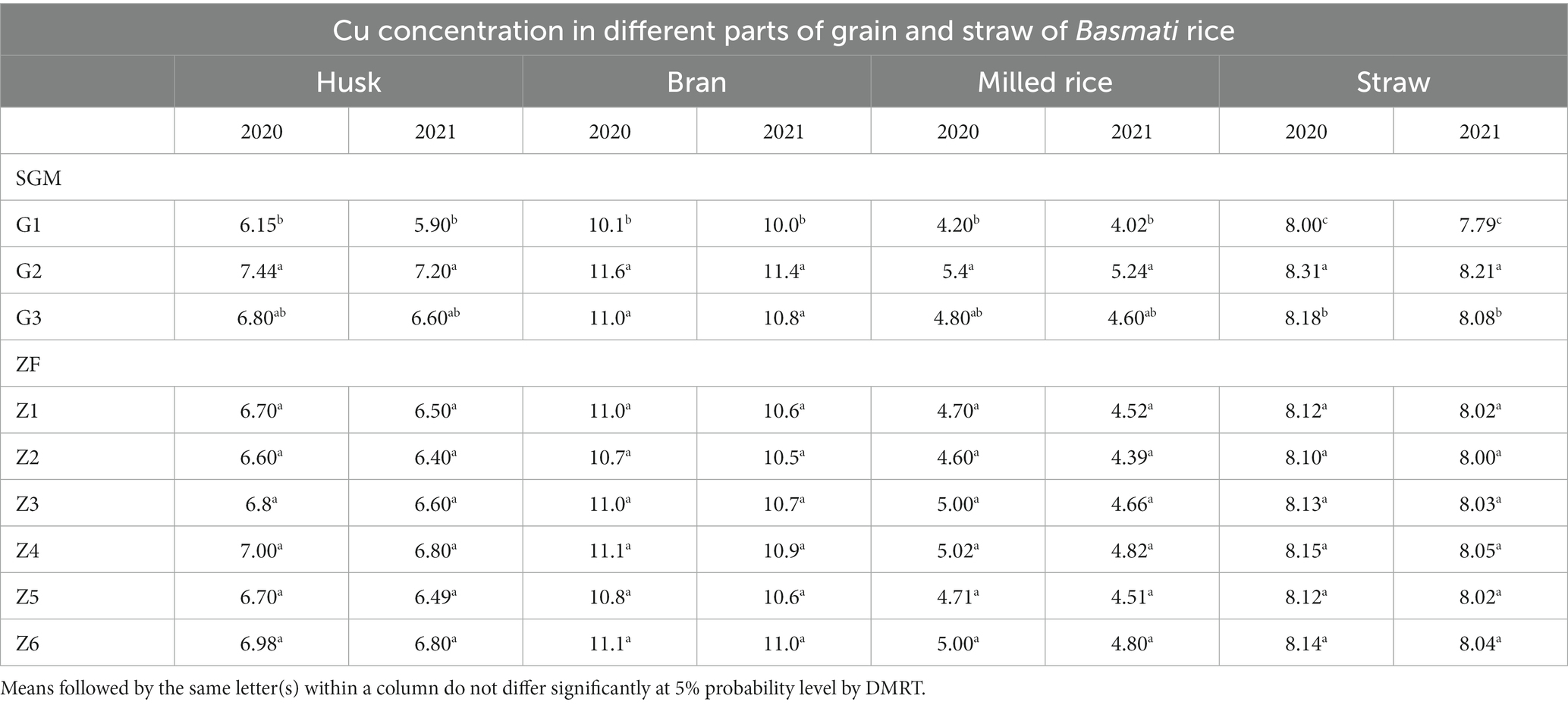
Table 7. Summer green manuring (SGM) and zinc fertilization (ZF) on Cu concentration (mg kg−1) in different parts of grain and straw of basmati rice.
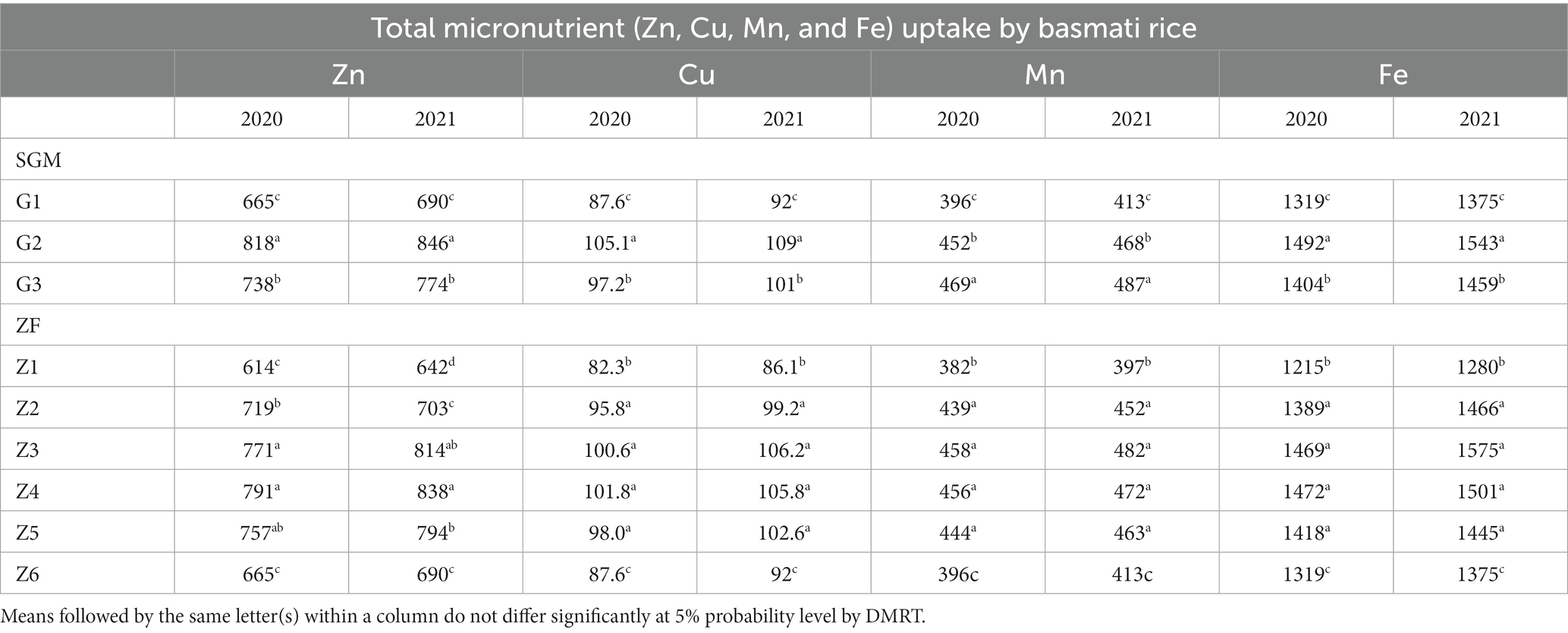
Table 8. Summer green manuring (SGM) and zinc fertilization (ZF) on total micronutrient (Zn, Cu, Mn, and Fe) uptake (g ha−1) by basmati rice.
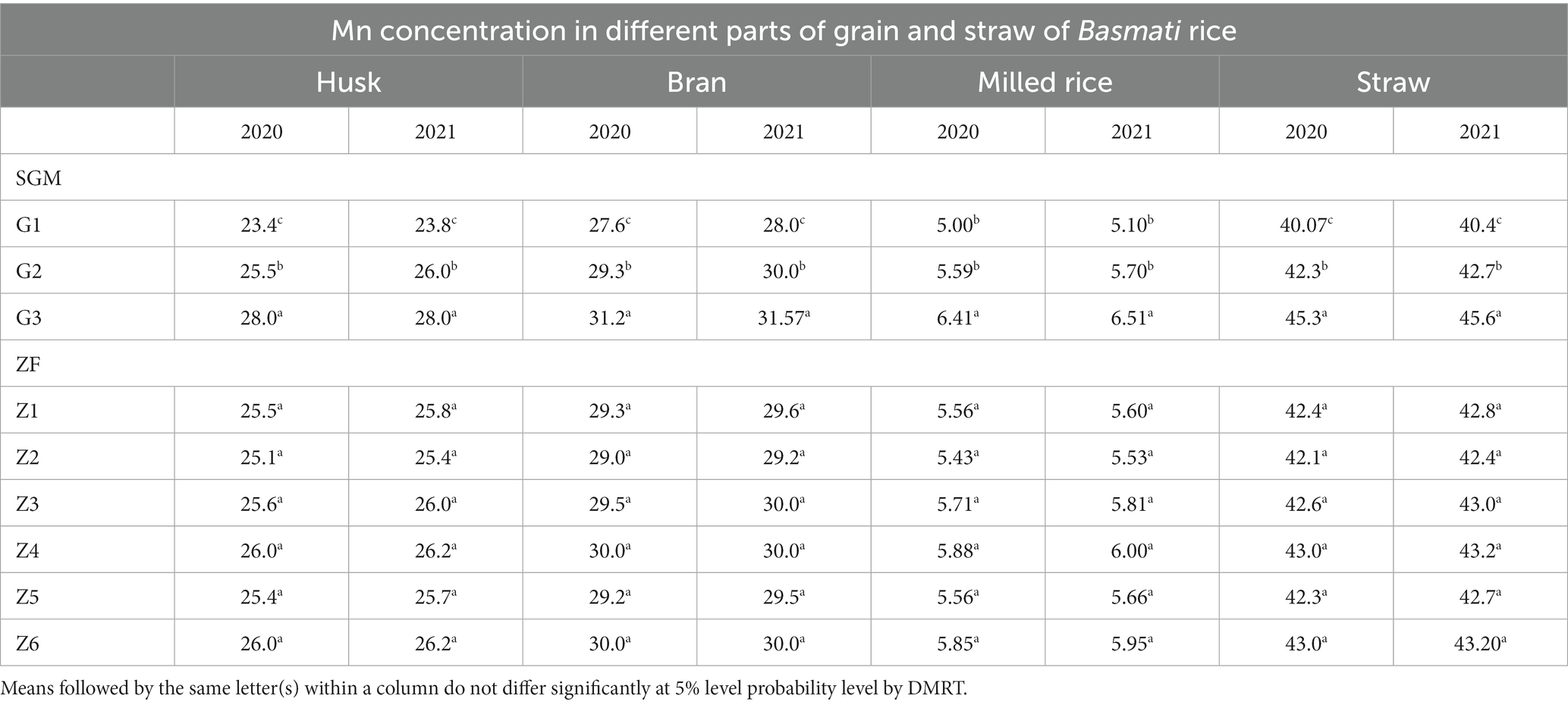
Table 9. Summer green manuring (SGM) and zinc fertilization (ZF) on Mn concentration (mg kg−1) in different parts of grain and straw of basmati rice.
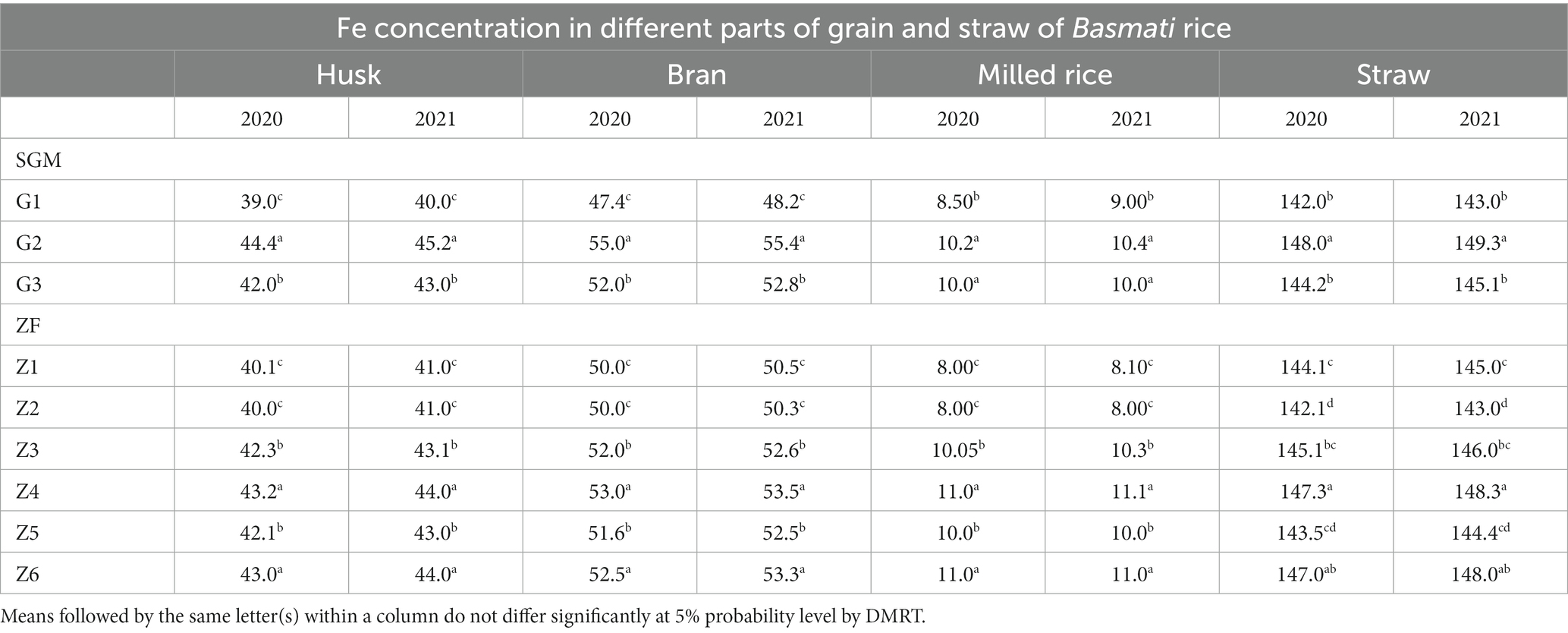
Table 10. Summer green manuring (SGM) and zinc fertilization (ZF) on Fe concentration (mg kg−1) in different parts of grain and straw of basmati rice.
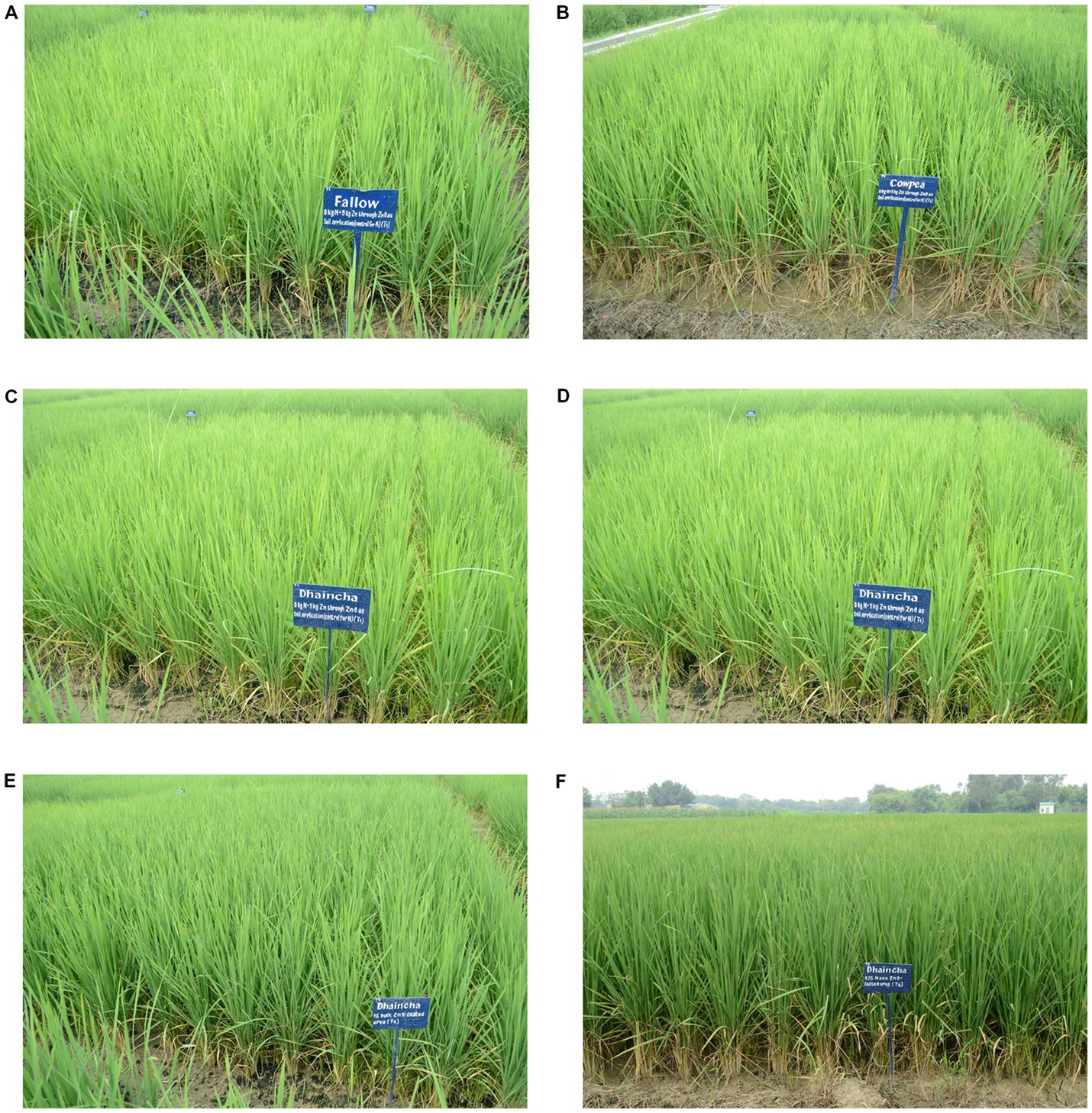
Figure 8. (A) Summer fallow +5 kg Zn ha−1- bulk ZnO. (B) Cowpea +5 kg Zn ha−1- bulk ZnO. (C) Sesbania + 5 kg Zn ha−1- bulk ZnO. (D) Sesbania + 5 kg Zn ha−1- bulk ZnO. (E) Sesbania + 1% bulk ZnO-coated urea. (F) Sesbania + 0.2% nano ZnO-coated urea.
Further, the application of zinc in conjunction with urea (both coating and separate application) significantly improved the Zn and Fe content (p < 0.01) in milled rice than sole urea application (Z2) and soil application of 5 kg Zn ha−1 through ZnO (Z1) as evident by contrast analysis (C2 and C3, Table 3) during both years of study. In contrast, averaged over SGM, Cu, and Mn content in milled rice were not significantly affected regardless of ZF treatment. Averaged over SGM, integrated application of zinc with urea significantly (p < 0.01) enhanced the Zn and Fe content in milled rice by 2.45 mg kg−1 and 2.52 mg kg−1, respectively during 2020 and by 2.63 mg kg−1 and 2.6 mg kg−1, respectively during 2021 than the sole application of 5 kg Zn ha−1 through ZnO (Z1). Relative to sole urea application, zinc, and urea together improved the Zn and Fe content in milled rice by 2.99 mg kg−1 and 2.62 mg kg−1, respectively during the first year and by 2.83 mg kg−1 and 2.6 mg kg−1, respectively during the second year of study.
SGM and ZF had a substantial impact on basmati rice’s total uptake of Zn, Cu, Mn, and Fe in both years (Table 8). Total micronutrient accumulation followed the pattern Fe > Zn > Mn > Cu. The effectiveness of SGM in terms of the total uptake of Zn, Cu, and Fe by basmati rice, as measured over a ZF treatment, followed the pattern Sesbania > cowpea > summer fallow. In both 2020 and 2021, the summer fallow had the lowest total micronutrient uptake. Cowpea, on the other hand, absorbed more manganese overall than any other green manure. In addition, the total uptake of micronutrients was dramatically enhanced by the use of zinc and urea in combination (both coating and separate application) as compared to the use of 5 kg Zn ha−1 applied to the soil. Over the summer fallow of 2020, we found an increase of 22.6% in total Zn, 18.4% in total Cu, 13.3% in total Mn, and 12.21% in total Fe, and in 2021, it was 23.0% for Zn, 19.97% for Cu, 14.14% for Mn, and 13.1% for Fe. In cowpea treated plot, the increment in total uptake was 12.17% in Zn, 10.97% in Cu, 17.9% in Mn, and 6.1% Fe during 2020 and 10.97% in Zn, 10.95% in Cu, 18.43% in Mn and 6.4% in Fe during 2021 compared to summer fallow.
Research findings pertaining to crude protein content in different parts of the grain and total crude protein yield are given in Table 11. SGM and ZF significantly influenced the crude protein in the grain of Basmati rice during both years of experimentation. The highest protein content in Basmati rice grain was observed when it was grown after Sesbania aculeata (G2) residue incorporated plot during both the years and it decreased in the order: Sesbania aculeata (G2) > Vigna unguiculata (G3) > summer fallow (G1). During both years, crude protein content followed the pattern: bran > milled rice > hull. On average, the crude protein content of milled was 8.24 and 8.38% during 2020 and 2021, respectively. Averaged over SGM, the integrated application of zinc with urea significantly influenced crude protein content in milled rice which outperformed both sole urea application (Z2) and soil application of 5 kg Zn ha−1 through ZnO (Z1). The performance of ZF sources in enriching the crude protein content in milled rice was in the order of 0.2% NZCU = 1% BZCU>0.1% NZCU = N through prilled urea +5 kg Zn ha−1 ZnO soil application > N through prilled urea > soil application of 5 kg Zn ha−1 through ZnO.
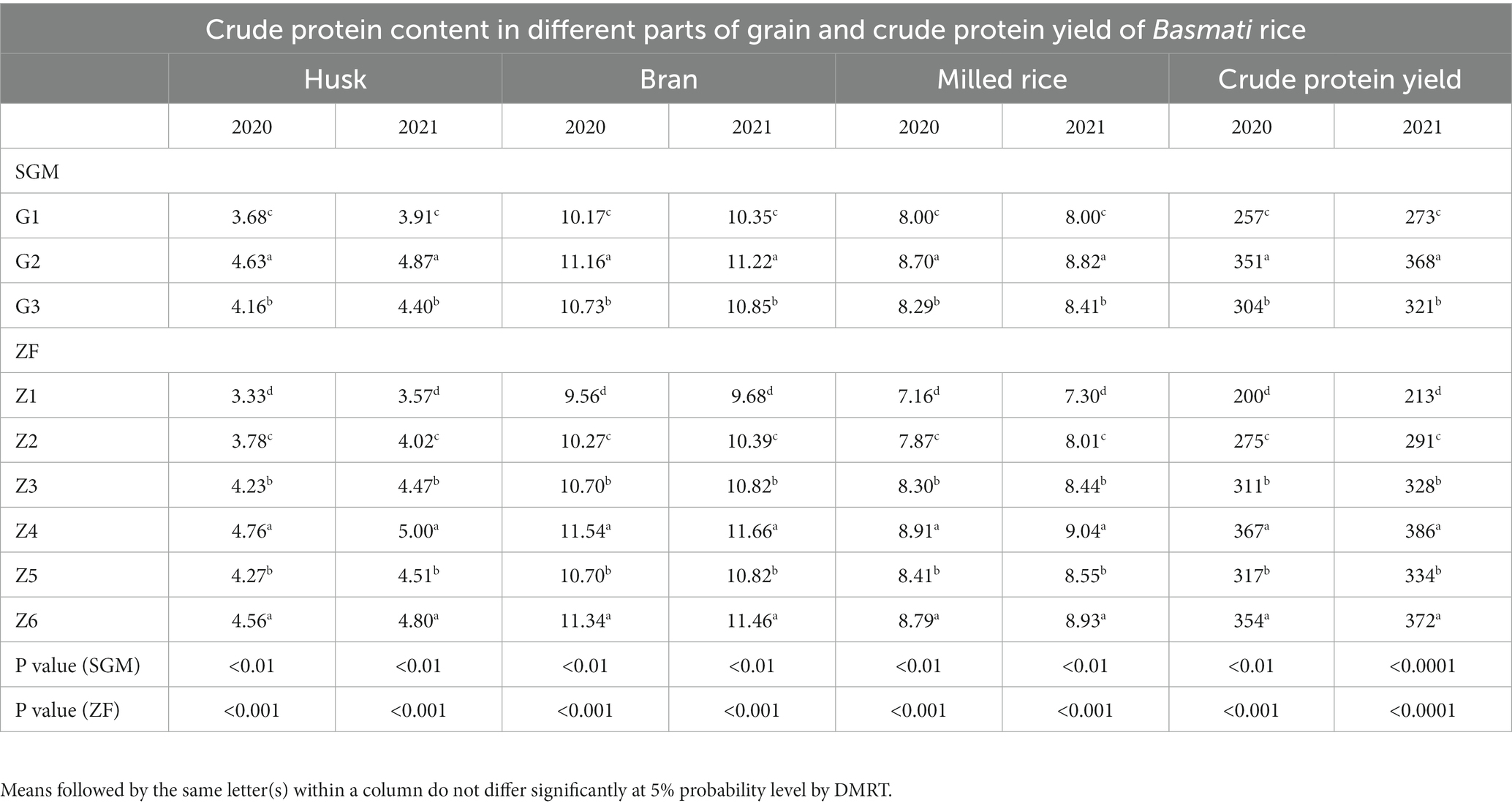
Table 11. Effect of summer green manuring (SGM) and zinc fertilization (ZF) on crude protein content (%) in different parts of grain and crude protein yield (kg ha−1) of basmati rice.
The correlation coefficients between the Zn concentration in different parts of the grain, uptake by grain, and total uptake, and N concentration in different parts of the grain, uptake by grain, and total uptake revealed that the quantity of Zn loading in different parts of grain was significantly and positively correlated (p < 0.01) with the N content in different parts of grain during both years (Table 12).
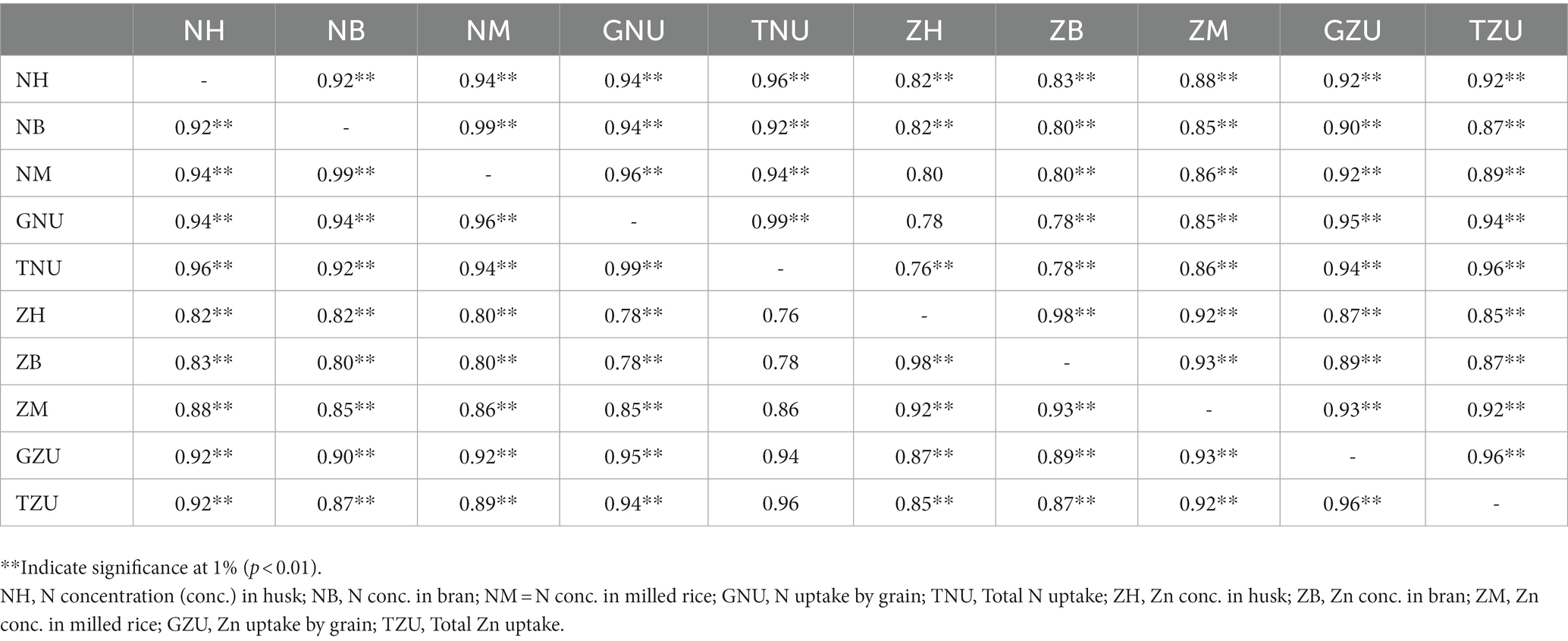
Table 12. Correlation matrix depicting correlation coefficients between Zn concentration and uptake vs. N concentration and uptake in basmati rice.
Leguminous green manure owing to a lower C/N ratio, decomposes quickly and results in net N mineralization (Khind, 1992). The incorporation of green manures adds a considerable amount of easily decomposable organic matter resulting buildup of organic carbon (Mandal et al., 2003), thereby promoting higher available N in the soil. Apart from the addition of nitrogen by green manuring, it contributed a significant amount of micronutrients thereby increasing the density of micronutrients in edible portions of food crops (Supplementary Table S1). Increased addition of micro-nutrient by summer green manuring compared to fallow promoted higher micronutrient and nitrogen-dense grain as reflected in our study. Sesbania-incorporated basmati rice outperformed cowpea in terms of increasing protein content and micronutrient density (except Mn) in rice grain factored by higher nitrogen and micronutrient addition associated with enhanced biomass production over both years. Our findings are consistent with Pooniya and Shivay (2013) who found that green manuring with Sesbania aculeata to basmati rice led to a higher accumulation of Zn, Fe, Cu and Mn and in the grain. Prior studies (Meena and Shivay, 2010) reported a positive effect of Sesbania on the agronomic profile of rice. The highest Mn content of cowpea green manured basmati rice can be attributed to significantly higher total Mn bioaccumulation in both root and shoot. Application of organic matter in the form of green manures leads to the release of decomposition products such as water-soluble organic ligands, e.g., citrate, oxalate, and malate (Jones et al., 2003) which have two-fold impacts (1) lowering of rhizosphere pH resulting in higher micronutrient bio-availability (2) complexing of these soil absorbed/fixed micronutrient thereby modulating their solubility (Evans, 1991). The incorporation of green manures in-situ may induce alterations in paddy rhizosphere like a more reducing environment driven by the addition of external carbon source, e.g., glucose and organic acids from the decomposed substrate which could accelerate the process of Fe+3 reduction, hence more bio-availability of Fe (Liu et al., 2013). A similar process might have promoted Mn availability and Mn-rich basmati rice grain. Organic matter also affects the activity and richness of soil microorganisms (Dhaliwal et al., 2019) consequently enhancing plant micronutrient uptake. Furthermore, organic matter improves soil structure, allowing plant roots to explore a wider soil volume (Mäder et al., 2002) and higher soil moisture retention facilitating nutrient transport to the plant roots. The deeper root penetration by summer green manuring than basmati rice might be another element that aided in the recycling of micronutrients from the subsurface layer to topsoil (Jat, 2010; Pooniya and Shivay, 2012).
The present report of increment in grain yield by application of nano-zinc oxide aligns with previous studies with rice (Bala et al., 2019; Jangid et al., 2019; Kheyri et al., 2019; Singh et al., 2019; Elshayb et al., 2021; Somaratne et al., 2021; Yang et al., 2021; Adhikary et al., 2022; Akmal et al., 2022; Sheykhzadeh et al., 2022; Waqas Mazhar et al., 2022) and with other crops like wheat (Babaei et al., 2017; Adrees et al., 2021; Sheoran et al., 2021; Adil et al., 2022). Conjoint application of nano zinc and urea has been shown to promote grain yield in rice (Kumar et al., 2022) and in wheat (Dimkpa et al., 2020; Asim et al., 2022; Beig et al., 2022). Previous agronomical studies have clearly demonstrated the beneficial effect of ZnO NPs in promoting enriched micronutrients, especially Zn, and improved quality parameters in grain of rice (Kheyri et al., 2019; Elshayb et al., 2021; Yang et al., 2021; Akmal et al., 2022) and wheat (Zhang et al., 2017; Munir et al., 2018; Zhu et al., 2020; Sheoran et al., 2021; Asim et al., 2022). This might be due to enhanced Zn uptake from ZnO NPs than bulk ZnO counterparts linked to the higher solubility of Zn in soil followed by preferential uptake of ZnO NPs by rice root. The Zn sufficiency in plant tissues from ZnO NPs can promote seed development and hence grain size and grain weight because Zn plays key roles in DNA polymerase activity as well as in cell division (Marschner, 2012). The higher Zn content in straw, hull, and bran compared to the rice kernel reflects low mobilization of Zn from different parts to the kernel, producing the lowest Zn content in the kernel indicating that when hull and bran are removed during hulling and milling, the grains lose a considerable proportion of their nutritional values. Interestingly, the dilution effect may account for the considerably reduced Zn concentration in several parts of rice grain and straw in lone urea-treated basmati rice (Table 6) compared to soil application of 5 kg Zn ha−1 using bulk ZnO (Jarrell and Beverly, 1981).
The improvement in nutrient content especially N (hence crude protein) in the grain of basmati rice by the application of ZnO NPs coated urea could be ascribed to enhanced nutrient mobilization in the soil by influencing the soil microbial population and extracellular enzymes secretion like urease in the soil (Raliya and Tarafdar, 2013), hence modulating available nitrogen in the soil. The application of 2% zinc-enriched urea outperformed other materials in raising N content which could be linked to synchronized released from the zinc-enriched urea (Shivay et al., 2008). In this context, it is worth noting that zinc content in edible parts of a grain of basmati rice was found to be highly correlated to N content in the grain. Since protein represents a sink for Zn due to the involvement of Zn in protein synthesis in the grain (Cakmak et al., 2010), an increase in crude protein content with Zn application is evident from our study. A possible explanation for the increased Zn concentration is the enhanced sink strength for Zn in grain caused by the increased N supply from summer green manure crops. Our findings corroborate with the findings of Hao et al. (2007) who found that N application promoted protein and accumulation of Zn content in grains. Our investigation has established that agronomic management using an appropriate combination of organic sources like green manuring and inorganic source like Zn-coated urea in basmati rice crop has the potential in modulating zinc levels in milled rice driven by synergistic nitrogen and zinc interaction can mitigate zinc malnutrition.
Our findings on basmati rice clearly demonstrated the effectiveness of these nano ZnO-urea assemblies in positively influencing and promoting the transportation of micronutrients and nitrogen into edible tissue. Notably, the yield response of the basmati rice treated with the 0.2% NZCU was comparable to those treated with a traditional fertilization strategy, i.e., 1% BZCU, despite the zinc rate being reduced by 20%. Since the aleurone layer is removed during milling, milled rice always has a lower mineral concentration. Thus, brown rice intake might be an alternative to milled rice for boosting micronutrient status in Asian diets. The delivery of micro-nutrients into plants using agronomic manipulations like summer green manuring and zinc-coated urea and the effective translocation of these nutrients into to edible portions of grain as demonstrated in the present study holds great promise for addressing the widespread micronutrient deficiency in plants and alleviating micronutrient malnutrition in human. Further, studies focusing on synergistic response factored by the integrated usage of green manure and nano ZnO coated urea for a variety of crop species, diverse cropping systems, and soil can be explored to fully understand the versatility and cost-effectiveness of these plant fertilization strategies. Our interventions could be advantageous for improving agri-food systems of rural households of India in combating protein-micronutrient malnutrition where the vast majority of the population relies largely on plant-based food like rice.
The original contributions presented in the study are included in the article/Supplementary material, further inquiries can be directed to the corresponding author.
KB, YS, and RP led the research work, planned, supervised, and conducted field experiments, and read and edited the manuscript. KB, SM, SN, and KR collected soil, plant samples and performed chemical analysis, also wrote the initial draft of the manuscript, and prepared figures and tables. RP, YS, DK, MS, DC, RK, and CS project supervision, reviewed, read, and edited the manuscript with significant contributions. BY performed the statistical analysis. All authors contributed to the article and approved the submitted version.
The authors acknowledge the ICAR-Indian Agricultural Research Institute and the Indian Council of Agricultural Research, New Delhi, India for the financial support and necessary facilities.
The authors declare that the research was conducted in the absence of any commercial or financial relationships that could be construed as a potential conflict of interest.
All claims expressed in this article are solely those of the authors and do not necessarily represent those of their affiliated organizations, or those of the publisher, the editors and the reviewers. Any product that may be evaluated in this article, or claim that may be made by its manufacturer, is not guaranteed or endorsed by the publisher.
The Supplementary material for this article can be found online at: https://www.frontiersin.org/articles/10.3389/fsufs.2023.1187717/full#supplementary-material
Adhikari, T., Kundu, S., Biswas, A. K., Tarafdar, J. C., and Subba, R. A. (2015). Characterization of zinc oxide nano particles and their effect on growth of maize (Zea mays L.) plant. J. Plant Nutr. 38, 1505–1515. doi: 10.1080/01904167.2014.992536
Adhikary, S., Biswas, B., Chakraborty, D., Timsina, J., Pal, S., Chandra Tarafdar, J., et al. (2022). Seed priming with selenium and zinc nanoparticles modifies germination, growth, and yield of direct-seeded rice (Oryza sativa L.). Sci. Rep. 12:7103. doi: 10.1038/s41598-022-11307-4
Adil, M., Bashir, S., Bashir, S., Aslam, Z., Ahmad, N., Younas, T., et al. (2022). Zinc oxide nanoparticles improved chlorophyll contents, physical parameters, and wheat yield under salt stress. Front. Plant Sci. 13:932861. doi: 10.3389/fpls.2022.932861
Adrees, M., Khan, Z. S., Hafeez, M., Rizwan, M., Hussain, K., Asrar, M., et al. (2021). Foliar exposure of zinc oxide nanoparticles improved the growth of wheat (Triticum aestivum L.) and decreased cadmium concentration in grains under simultaneous cd and water deficient stress. Ecotoxicol. Environ. Saf. 208:111627. doi: 10.1016/j.ecoenv.2020.111627
Akmal, M., Younus, A., Wakeel, A., Jamil, Y., and Rashid, M. A. (2022). Synthesis and application of optimized ZnO nanoparticles for improving yield and Zn content of rice (Oryza sativa L.) grain. J. Plant Nutr. 46, 1077–1090. doi: 10.1080/01904167.2022.2087090
APEDA . (n.d.). Available at: https://apeda.gov.in/apedawebsite/SubHead_Products/Basmati_Rice.htm. (Accessed January 15, 2023).
Asim, M., Ahmad, W., Qamar, Z., Awais, M., Nepal, J., and Ahmad, I. (2022). Seed coating with zinc oxide nanofiber (ZnONF) and urea improved zinc uptake; recovery efficiency, growth, and yield of bread wheat (Triticum aestivum L.). J. Soil Sci. Plant Nutr. 22, 5009–5020. doi: 10.1007/s42729-022-00978-7
Babaei, K., Seyed Sharifi, R., Pirzad, A., and Khalilzadeh, R. (2017). Effects of bio fertilizer and nano Zn-Fe oxide on physiological traits, antioxidant enzymes activity and yield of wheat (Triticum aestivum L.) under salinity stress. J. Plant Interact. 12, 381–389. doi: 10.1080/17429145.2017.1371798
Bala, R., Kalia, A., and Dhaliwal, S. S. (2019). Evaluation of efficacy of ZnO nanoparticles as remedial zinc nanofertilizer for rice. J. Soil Sci. Plant Nutr. 19, 379–389. doi: 10.1007/s42729-019-00040-z
Beig, B., Niazi, M. B., Jahan, Z., Zia, M., Shah, G. A., Iqbal, Z., et al. (2022). Facile coating of micronutrient zinc for slow release urea and its agronomic effects on field grown wheat (Triticum aestivum L.). Sci. Total Environ. 838:155965. doi: 10.1016/j.scitotenv.2022.155965
Bhatt, R., Kukal, S. S., Busari, M. A., Arora, S., and Yadav, M. (2016). Sustainability issues on rice-wheat cropping system. Int. Soil Water Conserv. Res. 4, 64–74. doi: 10.1016/j.iswcr.2015.12.001
Boparai, B. S., Singh, Y., and Sharma, B. D. (1992). Effect of green manuring with Sesbania aculeata on physical properties of soil and on growth of wheat in rice-wheat and maize-wheat cropping systems in a semiarid region of India. Arid Land Res. Manag. 6, 135–143. doi: 10.1080/15324989209381306
Cakmak, I., Pfeiffer, W. H., and McClafferty, B. (2010). Biofortification of durum wheat with zinc and iron. Cereal Chem. 87, 10–20. doi: 10.1094/CCHEM-87-1-0010
Cole, J. C., Smith, M. W., Penn, C. J., Cheary, B. S., and Conaghan, K. J. (2016). Nitrogen, phosphorus, calcium, and magnesium applied individually or as a slow release or controlled release fertilizer increase growth and yield and affect macronutrient and micronutrient concentration and content of field-grown tomato plants. Sci. Hortic. 211, 420–430. doi: 10.1016/j.scienta.2016.09.028
De Mendiburu, F., and de Mendiburu, M. F. (2019). Package ‘agricolae’ statistical procedures for agricultural research. R Package, version. 1.3.1
Dhaliwal, S. S., Naresh, R. K., Mandal, A., Singh, R., and Dhaliwal, M. K. (2019). Dynamics and transformations of micronutrients in agricultural soils as influenced by organic matter build-up: a review. Environ. Sustain. Indic. 1-2:100007. doi: 10.1016/j.indic.2019.100007
Dimkpa, C. O., Andrews, J., Fugice, J., Singh, U., Bindraban, P. S., Elmer, W. H., et al. (2020). Facile coating of urea with low-dose ZnO nanoparticles promotes wheat performance and enhances Zn uptake under drought stress. Front. Plant Sci. 11:168. doi: 10.3389/fpls.2020.00168
Elshayb, O. M., Farroh, K. Y., Amin, H. E., and Atta, A. M. (2021). Green synthesis of zinc oxide nanoparticles: fortification for rice grain yield and nutrients uptake enhancement. Molecules 26:584. doi: 10.3390/molecules26030584
Evans, L. T. (1996). Crop evolution, adaptation and yield. Cambridge, UK: Cambridge University Press.
Evans, A. (1991). Influence of low molecular weight organic acids on zinc distribution within micronutrient pools and zinc uptake by wheat. J. Plant Nutr. 14, 1307–1318. doi: 10.1080/01904169109364287
The Global Hunger Index . (2022). Global Hunger Index. Available at: www.globalhungerindex.org.
Hanway, J., and Heidel, H. (1952). Soil analysis methods as used in Iowa state college soil testing laboratory. Iowa State Coll. Agric. Bull. 57:131.
Hao, H. L., Wei, Y. Z., Yang, X. E., Ying, F. E., and Wu, C. Y. (2007). Effects of different nitrogen fertilizer levels on Fe, Mn, cu and Zn concentrations in shoot and grain quality in rice (Oryza sativa). Rice Sci. 14, 289–294. doi: 10.1016/S1672-6308(08)60007-4
Jangid, B., Srinivas, A., Kumar, M. R., Ramprakash, T., Prasad, T. N., Kumar, A. K., et al. (2019). Influence of zinc oxide nanoparticles foliar application on zinc uptake of rice (Oryza sativa L.) under different establishment methods. Int. J. Chem. Stud. 7, 257–261.
Jarrell, W. M., and Beverly, R. B. (1981). The dilution effect in plant nutrition studies. Adv. Agron. 34, 197–224. doi: 10.1016/S0065-2113(08)60887-1
Jat, S. L.. (2010). Effect of dual purpose summer legumes and zinc fertilization on productivity and quality of aromatic hybrid rice and their residual effects on succeeding wheat grown in a summer legume-rice-wheat cropping system. (Doctoral dissertation, PhD thesis, Indian Agricultural Research Institute (IARI), New Delhi, India).
Jones, D. L., Dennis, P. G., Owen, A. G., and Van Hees, P. A. (2003). Organic acid behavior in soils–misconceptions and knowledge gaps. Plant Soil 248, 31–41. doi: 10.1023/A:1022304332313
Juliano, B. O. (1985). Rice: Chemistry and technology. The American Association of Cereal Chemists. Inc. St. Paul, Minnesota, USA, 774.
Kheyri, N., Norouzi, H. A., Mobasser, H. R., and Torabi, B. (2019). Effects of silicon and zinc nanoparticles on growth, yield, and biochemical characteristics of rice. Agron. J. 111, 3084–3090. doi: 10.2134/agronj2019.04.0304
Khind, C. S. (1992). Nutrient transformations in soils amended with green manures. Adv. Soil Sci. 17, 237–309. doi: 10.1007/978-1-4612-2930-8_5
Kumar, S. A., Chhabra, V., Sreethu, S., and Kaur, G. (2022). Response of rice cultivars to conventional and nano fertilizers on yield and yield attributes in the central plain zone of Punjab. Pharm. Innov. J. 11, 1320–1323.
Kumar, N., Chhokar, R. S., Meena, R. P., Kharub, A. S., Gill, S. C., Tripathi, S. C., et al. (2021). Challenges and opportunities in productivity and sustainability of rice cultivation system: a critical review in Indian perspective. Cereal Res. Commun. 50, 573–601. doi: 10.1007/s42976-021-00214-5
Ladha, J. K., and Kundu, D. K.. (1997). Legumes for sustaining soil fertility in lowland rice. In: Extending nitrogen fixation research to farmers’ fields: Proceedings of an international workshop on managing legume nitrogen fixation in the cropping system of Asia. ICRISAT Asia Centre, Patancheru, India. 76–102.
Lin, C. J., Li, C. Y., Lin, S. K., Yang, F. H., Huang, J. J., Liu, Y. H., et al. (2010). Influence of high temperature during grain filling on the accumulation of storage proteins and grain quality in rice (Oryza sativa L.). J. Agric. Food Chem. 58, 10545–10552. doi: 10.1021/jf101575j
Lindsay, W. L., and Norvell, W. A. (1978). Development of a DTPA soil test for zinc, iron, manganese and copper. Soil Sci. Soc. Am. J. 42, 421–428. doi: 10.2136/sssaj1978.03615995004200030009x
Liu, Y., Li, F. B., Xia, W., Xu, J. M., and Yu, X. S. (2013). Association between ferrous iron accumulation and pentachlorophenol degradation at the paddy soil–water interface in the presence of exogenous low-molecular-weight dissolved organic carbon. Chemosphere 91, 1547–1555. doi: 10.1016/j.chemosphere.2012.12.040
Ma, D., Yin, L., Ju, W., Li, X., Liu, X., Deng, X., et al. (2021). Meta-analysis of green manure effects on soil properties and crop yield in northern China. Field Crop Res. 266:108146. doi: 10.1016/j.fcr.2021.108146
Mäder, P., Fliessbach, A., Dubois, D., Gunst, L., Fried, P., and Niggli, U. (2002). Soil fertility and biodiversity in organic farming. Science 296, 1694–1697. doi: 10.1126/science.1071148
Mandal, U. K., Singh, G., Victor, U. S., and Sharma, K. L. (2003). Green manuring: its effect on soil properties and crop growth under rice-wheat cropping system. Eur. J. Agron. 19, 225–237. doi: 10.1016/S1161-0301(02)00037-0
Meena, H. N., and Shivay, Y. S. (2010). Productivity of short-duration summer forage crops and their effect on succeeding aromatic rice in conjunction with gypsum-enriched urea. Indian J. Agron. 55, 11–15.
Mohanty, S., Nayak, A. K., Bhaduri, D., Swain, C. K., Kumar, A., Tripathi, R., et al. (2021). Real-time application of neem-coated urea for enhancing N-use efficiency and minimizing the yield gap between aerobic direct-seeded and puddled transplanted rice. Field Crop Res. 264:108072. doi: 10.1016/j.fcr.2021.108072
Munir, T., Rizwan, M., Kashif, M., Shahzad, A., Ali, S., Amin, N., et al. (2018). Effect of zinc oxide nanoparticles on the growth and Zn uptake in wheat (Triticum aestivum L.) by seed priming method. Digest J. Nanomater. Biostruct. 13, 315–323.
Nawaz, A., Farooq, M., Nadeem, F., Siddique, K. H., and Lal, R. (2019). Rice-wheat cropping systems in South Asia: issues, options and opportunities. Crop Pasture Sci. 70, 395–427. doi: 10.1071/CP18383
Olsen, R., Cole, C. V., Watanabe, F. S., and Dean, L. A. (1954). Estimation of available phosphorus in soils by extraction with sodium bicarbonate. United States Department of Agriculture, Washington, DC, USA.
Pahalvi, H. N., Rafiya, L., Rashid, S., Nisar, B., and Kamili, A. N. (2021). “Chemical fertilizers and their impact on soil health. Microbiota and biofertilizers” in Ecofriendly tools for reclamation of degraded soil environs. eds. G. H. Dar, R. A. Bhat, and M. A. Mehmood, vol. 2 (Berlin: Springer), 1–20.
Pavithra, G. J., Rajashekar Reddy, B. H., Salimath, M., Geetha, K. N., and Shankar, A. G. (2017). Zinc oxide nano particles increases Zn uptake, translocation in rice with positive effect on growth, yield and moisture stress tolerance. Indian J. Plant Physiol. 22, 287–294. doi: 10.1007/s40502-017-0303-2
Piper, C. S. (1966). “Hydrogen ion concentration, conductivity and water soluble salts” in Soil and plant analysis (Bombay, Maharashtra, India: Hans Publishers), 7–46.
Pooniya, V., and Shivay, Y. S. (2012). Summer green-manuring crops and zinc fertilization on productivity and economics of basmati rice (Oryza sativa L.). Arch. Agron. Soil Sci. 58, 593–616. doi: 10.1080/03650340.2010.535205
Pooniya, V., and Shivay, Y. S. (2013). Enrichment of basmati rice grain and straw with zinc and nitrogen through ferti-fortification and summer green manuring under Indo-Gangetic Plains of India. J. Plant Nutr. 36, 91–117. doi: 10.1080/01904167.2012.733052
Prasad, R. (2005). Rice–wheat cropping systems. Adv. Agron. 86, 255–339. doi: 10.1016/S0065-2113(05)86006-7
Prasad, R., Shivay, Y. S., Kumar, D., and Sharma, S. N. (2006). Learning by doing exercises in soil fertility (a practical manual for soil fertility). New Delhi, Division of Agronomy, Indian Agricultural Research Institute, 68.
Raliya, R., and Tarafdar, J. C. (2013). ZnO nanoparticle biosynthesis and its effect on phosphorous-mobilizing enzyme secretion and gum contents in clusterbean (Cyamopsis tetragonoloba L.). Agric. Res. 2, 48–57. doi: 10.1007/s40003-012-0049-z
Rizwan, M., Ali, S., Ali, B., Adrees, M., Arshad, M., Hussain, A., et al. (2019). Zinc and iron oxide nanoparticles improved the plant growth and reduced the oxidative stress and cadmium concentration in wheat. Chemosphere 214, 269–277. doi: 10.1016/j.chemosphere.2018.09.120
Salahin, N., Alam, M. K., Islam, M. M., Naher, L., and Majid, N. M. (2013). Effects of green manure crops and tillage practice on maize and rice yields and soil properties. Aust. J. Crop. Sci. 7, 1901–1911.
Sharma, S., Saikia, R., Thind, H. S., Singh, Y., and Jat, M. L. (2021). Tillage, green manure and residue management accelerate soil carbon pools and hydrolytic enzymatic activities for conservation agriculture based rice-wheat systems. Commun. Soil Sci. Plant Anal. 52, 470–486. doi: 10.1080/00103624.2020.1862147
Sheoran, P., Grewal, S., Kumari, S., and Goel, S. (2021). Enhancement of growth and yield, leaching reduction in Triticum aestivum using biogenic synthesized zinc oxide nanofertilizer. Biocatal. Agric. Biotechnol. 32:101938. doi: 10.1016/j.bcab.2021.101938
Sheykhzadeh, M., Mobasser, H., Petrodi, E. R., and Rezvani, M. (2022). Silicon and zinc improves grain yield and nutrient status in rice when supplied during the different growth stages. Roman Agric. Res. 39, 1–3.
Shivay, Y. S., Kumar, D., Prasad, R., and Ahlawat, I. P. (2008). Relative yield and zinc uptake by rice from zinc sulphate and zinc oxide coatings onto urea. Nutr. Cycl. Agroecosyst. 80, 181–188. doi: 10.1007/s10705-007-9131-5
Shivay, Y. S., Pooniya, V., Prasad, R., Pal, M., and Bansal, R. J. (2016). Sulphur-coated urea as a source of Sulphur and an enhanced efficiency of nitrogen fertilizer for spring wheat. Cereal Res. Commun. 44, 513–523. doi: 10.1556/0806.44.2016.002
Singh, K., Madhusudanan, M., and Ramawat, N. (2019). Synthesis and characterization of zinc oxide nano particles (ZnO NPs) and their effect on growth, Zn content and yield of rice (Oryza sativa L.). Synthesis 6, 9750–9754.
Singh, A., and Shivay, Y. S. (2019). Effects of green manures and zinc fertilizer sources on DTPA-extractable zinc in soil and zinc content in basmati rice plants at different growth stages. Pedosphere 29, 504–515. doi: 10.1016/S1002-0160(17)60442-9
Somaratne, S., Weerakoon, S. R., Karthikeyan, N., Munasinghe, D. S., and Widanapathirana, K. N. (2021). The impact of nano-ZnO foliar fertilizer on growth and yield of cultivated rice (Oryza sativa L.) varieties in Sri Lanka. Ceylon J. Sci. 50, 109–119. doi: 10.4038/cjs.v50i2.7872
Subbiah, B. V., and Asija, G. L. (1956). A rapid procedure for the estimation of available nitrogen in soils. Curr. Sci. 25, 259–260.
Tarafdar, J. C., Raliya, R., Mahawar, H., and Rathore, I. (2014). Development of zinc nanofertilizer to enhance crop production in pearl millet (Pennisetum americanum). Agric. Res. 3, 257–262. doi: 10.1007/s40003-014-0113-y
Thind, H. S., Sharma, S., Singh, Y., and Sidhu, H. S. (2019). Rice-wheat productivity and profitability with residue, tillage and green manure management. Nutr. Cycl. Agroecosyst. 113, 113–125. doi: 10.1007/s10705-018-09967-8
Timsina, J., and Connor, D. J. (2001). Productivity and management of rice-wheat cropping systems: issues and challenges. Field Crop Res. 69, 93–132. doi: 10.1016/S0378-4290(00)00143-X
Walkley, A. J., and Black, I. A. (1934). An examination of the Degtjareff method for determination of soil organic matter and a proposed modification of the chromic acid titration method. Soil Sci. 37, 29–38. doi: 10.1097/00010694-193401000-00003
Waqas Mazhar, M., Ishtiaq, M., Hussain, I., Parveen, A., Hayat Bhatti, K., Azeem, M., et al. (2022). Seed nano-priming with zinc oxide nanoparticles in rice mitigates drought and enhances agronomic profile. PLoS One 17:e0264967. doi: 10.1371/journal.pone.0264967
Yadav, R. L., Dwivedi, B. S., and Pandey, P. S. (2000). Rice-wheat cropping system: assessment of sustainability under green manuring and chemical fertilizer inputs. Field Crop Res. 65, 15–30. doi: 10.1016/S0378-4290(99)00066-0
Yang, G., Yuan, H., Ji, H., Liu, H., Zhang, Y., Wang, G., et al. (2021). Effect of ZnO nanoparticles on the productivity, Zn biofortification, and nutritional quality of rice in a life cycle study. Plant Physiol. Biochem. 163, 87–94. doi: 10.1016/j.plaphy.2021.03.053
Zhang, T., Sun, H., Lv, Z., Cui, L., Mao, H., and Kopittke, P. M. (2017). Using synchrotron-based approaches to examine the foliar application of ZnSO4 and ZnO nanoparticles for field-grown winter wheat. J. Agric. Food Chem. 66, 2572–2579. doi: 10.1021/acs.jafc.7b04153
Keywords: basmati rice, green manuring, micronutrients, nano ZnO, protein
Citation: Baral K, Shivay YS, Prasanna R, Kumar D, Shrivastava M, Chakraborty D, Kumar R, Srinivasarao C, Mandi S, Nayak S, Reddy KS and Yashavanth BS (2023) Interplay between nano zinc oxide-coated urea and summer green manuring in basmati rice under basmati rice-wheat cropping system: implications on yield response, nutrient acquisition and grain fortification. Front. Sustain. Food Syst. 7:1187717. doi: 10.3389/fsufs.2023.1187717
Received: 16 March 2023; Accepted: 20 April 2023;
Published: 17 May 2023.
Edited by:
Jayanta Layek, The ICAR Research Complex for North Eastern Hill Region, IndiaReviewed by:
Kulasekaran Ramesh, Indian Institute of Oilseeds Research (ICAR), IndiaCopyright © 2023 Baral, Shivay, Prasanna, Kumar, Shrivastava, Chakraborty, Kumar, Srinivasarao, Mandi, Nayak, Reddy and Yashavanth. This is an open-access article distributed under the terms of the Creative Commons Attribution License (CC BY). The use, distribution or reproduction in other forums is permitted, provided the original author(s) and the copyright owner(s) are credited and that the original publication in this journal is cited, in accordance with accepted academic practice. No use, distribution or reproduction is permitted which does not comply with these terms.
*Correspondence: Yashbir Singh Shivay, eXNzaGl2YXlAaG90bWFpbC5jb20=
Disclaimer: All claims expressed in this article are solely those of the authors and do not necessarily represent those of their affiliated organizations, or those of the publisher, the editors and the reviewers. Any product that may be evaluated in this article or claim that may be made by its manufacturer is not guaranteed or endorsed by the publisher.
Research integrity at Frontiers

Learn more about the work of our research integrity team to safeguard the quality of each article we publish.